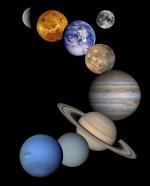|
This section contains 1,185 words (approx. 4 pages at 300 words per page) |

|
The solar system is comprised of the Sun and the celestial bodies which it holds in orbit around it by its gravitational force. The Sun itself makes up 99.8 percent of the solar system's mass, while Jupiter, the largest planet, contains only 0.1 percent. The other planets, their satellites and rings, asteroids, comets, dust and debris constitute the remainder.
Originally, the Earth was considered to be the center around which the Sun, Moon, and the five visible planets revolved. Comets, however, were not believed to be a part of the solar system, but rather a phenomenon of the Earth's atmosphere. This geocentric view of the solar system was also called the Ptolemaic view after the ancient Greek author, Ptolemy, who first published the idea in the second century A.D. Philosophers and scientists in Rome and later Europe adhered to this theory for the next thousand years, in...
|
This section contains 1,185 words (approx. 4 pages at 300 words per page) |

|


